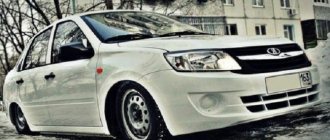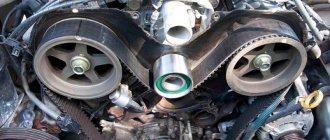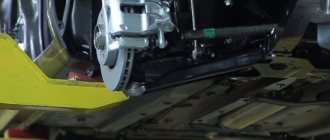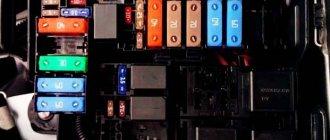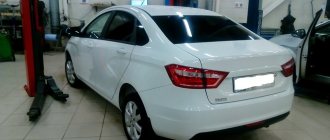For the last five years in Russia, the Renault Logan car has taken the place of the leader. But in 16, or rather in 15, he had a competitor, Lada Vesta. Let's determine which is better. Which car is still in the lead? Vesta strives to give the driver comfort and variety of equipment no worse than Logan, and in some places it even wins. In comparison, you can immediately see some factors that are in the lead. Vesta is a budget car, Logan is also a budget car, which means it is the most popular - so the battle is for every buyer. Among budget employees, Renault Logan has a high sales rating, or even a leader in its class. It has been on sale for about 10 years and has found its niche and has its own buyer. Lada Vesta was released in 2015; its popularity soared, if you look at sales, and Logan has been selling steadily for a long time and the model was restyled Renault Logan 2 - which time will tell. We were able to compare these cars - read the comparison and make your choice.
AvtoVAZ promised that Vesta would be beautiful in appearance, more powerful, and practical in practice. During assembly, high-quality materials were used, at a relatively low price - the golden mean for a budget employee. Logan, in turn, is affordable for average Russians, it is reliable, unpretentious, and the price is not off the charts; it deserves special mention; it is a fairly strong car. Version Logan 2, well suited for harsh climates, is definitely a car for Russia. The updated version of Logan proved to be a picky car with cheap spare parts.
Vehicle platforms
These two cars are leaders in their class, but Vesta still outperforms Logan on the platform. Due to its dimensions, the Lada Vesta belongs to the B plus platform and, indeed, in many respects, it is several centimeters larger than its competitors. Logan belongs to category B and is less than Vesta.
A platform was specially developed for the Lada Vesta. The car is perfectly tuned to the climatic conditions of Russia. Well, the restyled Logan 2, unlike the first generation, is equipped with new parts and settings - it has been completely reconfigured.
Prices and options
Content
The Lada Vesta 2021 model year is presented in five versions: “Standard”, “Classic”, “Comfort”, “Luxe” and “Exclusive”, and the Renault Logan 2021 - in four: “Access”, “Life”, “Drive” and "Style". The most affordable Vesta “Standard” with a 1.6-liter engine (106 hp) and a 5-speed manual transmission costs 599,900 rubles, and the Logan “Access” with a 1.6-liter engine (82 hp). ) and a five-speed manual transmission - 569,000 rubles, that is, 30,900 rubles. (5%) cheaper. Both sedans are equipped with: driver's front airbag and ABS. The domestic model also received: a front passenger airbag, the Era-Glonass system and ESC dynamic stabilization, electric windows for the front doors, electric drive and heated side mirrors. The “Frenchman” has only “Era-Glonass” for 11,990 rubles as additional options for the “Access” package. In general, these cars can be safely called “empty”, but the “Russian” looks preferable, more than compensating for the high price with the installed equipment and a powerful engine.
Now let's compare the "budget" versions of sedans with automatic transmissions. You just need to clarify right away that the Lada is not equipped with a classic automatic transmission, but with a 5-speed robotic transmission. Lada Vesta “Classic” with the mandatory package of options “Start” 1.6 (106 hp) 5AMT costs 669,900 rubles, and Renault Logan “Life” 1.6 (102 hp) 4AT costs 724,990 rubles, that is, for 55,090 rubles. (8%) more expensive. Both models will delight future owners with the presence of air conditioning. As for the rest of the equipment, the “Frenchman” closes the gap from its rival, having received, in addition to the initial equipment, front electric windows and a second frontal airbag for the passenger. But the “Russian” also gets heated front seats and still offers a more competitive price.
Let's not dwell in detail on all the intermediate trim levels, but immediately compare the top versions of sedans. Lada Vesta “Exclusive” 1.8 (122 hp) 5AMT costs 874,400 rubles, and Renault Logan “Style” 1.6 (102 hp) 4AT costs 830,990 rubles, that is, 43,410 rubles. (5%) cheaper. The cars are equipped to the maximum, they now have: climate control, cruise control, rear electric windows, an audio system and front side airbags. But Vesta, unlike its rival, has Era-Glonass and a 7-inch touchscreen multimedia system with navigation. Adding their cost (11,990 rubles and 15,990 rubles, respectively) to the price of a French car, you get 858,970 rubles. And if we also take into account the less powerful engine of the “French”, the difference in cost will be minimal. Therefore, we can say that in the top versions the rivals have almost the same price tag.
Body and design
Naturally, you shouldn’t compare Vesta with the first version of Logan. It was a square design 10 years ago. After restyling, Renault was completely transformed, all the qualities it inherited from the first model have not disappeared anywhere, it is still durable and unpretentious. However, its design is more strict, although everything combines well, but Vesta also does not suffer from poor form. When developing Logan, the designers did not rely on design; most likely, it was designed for simple forms - using the machine for work.
Vesta stands out because its design lines are thoughtful and also elegant. Logan beats the Vesta by only 2 centimeters in body height. In terms of length/width, 2180 wins: 4410 versus 4345 millimeters.
To sum up the design, let's say: due to its simplicity, Logan loses to the news.
Where to stop?
Both cars seem to play in the same league, but conceptually they are seriously different from each other. Logan Stepway is extremely functional and pragmatic. There is nothing superfluous in it. It is reliable, but too simple in its initial design. The main questions are raised by ergonomics: the front seats are uncomfortable, some switch buttons are located illogically, and the multimedia screen is based too low - you have to look away from the road, which is unsafe.
At the time of its debut, the Lada Vesta Cross was the only “off-road” sedan in the segment. |
The elevated version of Logan appeared on foreign markets a year ago, but it has only just reached us. |
The Lada's trunk volume is slightly smaller than that of its opponent, but the gap is not critical: 480 liters versus 510. |
Logan's trunk holds 510 liters - the same as sedans two classes higher. |
Lada Vesta Cross looks more modern both outside and inside. There are far fewer complaints about the ergonomics of the Lada: the seats are more comfortable, the steering wheel is adjustable in two planes (in Renault - only in tilt), and the buttons are where they are needed. However, some Vest owners complain about oil burns, some about a rattling suspension or an unclearly tuned power steering. If you come across a copy assembled according to Feng Shui (and the vast majority of them are), the car will only delight you. Personally, I would choose Lada out of these two.
- You can buy an inexpensive towbar, radiator protection and trunk for Logan Stepway in our online store.
Lada Vesta Cross or Renault Logan Stepway - what to choose?
Engines and resource
The French car entered the market with only two engines. Vesta has two Russian-developed engines, one of them is 1.6 liters and the other is 1.8 liters. In terms of power characteristics, Vesta is also ahead. Engine 106,122 horsepower, versus 82, 102 Loganovsky. The basic version 2180 is equipped with a 106 horsepower engine and the top version with 122 horsepower. At this point we give a plus to Lada Vesta.
Renault is the leader in the resource, Logan engines travel about 400 thousand km without major repairs.
On Vesta, if the timing belt breaks, it bends the valves and the engine dies. Engines 2180 run differently because there are 2 of them. Engine 21129, thanks to its simple design, can be looked after without major repairs for 250,000 km - it will go even more if you take care of it.
If we talk about the service life, it depends on the owner of the car; there was one example that traveled 400,000 km without major repairs. There were some that went 50,000 and then needed major repairs, so it all depends on the driver.
Specifications
The length/width/height of the Lada Vesta 2021 are 4410/1764/1497 mm, and the dimensions of the Renault Logan 2021 are 4359/1733/1523 mm, that is, Vesta is longer, wider, but lower. The wheelbase is the same - 2635 mm. Ground clearance: 178 mm for the “Russian”, 172 mm for the “French”. The luggage compartment volume is more spacious in the French sedan: 510 liters versus 480 liters in the competitor. Vesta has a larger fuel tank: 55 liters versus 50 liters for its rival.
Lada Vesta is represented by two 1.6-liter engines: 106 hp. (148 Nm) and 122 hp. (170 Nm), and Renault Logan - three: 82 hp. (134 Nm), 102 hp. (145 Nm) and 113 hp. (152 Nm). Opponents have two transmission options: 5-speed manual and robotic gearboxes for the “Russian” and 5-speed “mechanics” and 4-speed “automatic” for the “Frenchman”. But despite the larger number of engines Renault has, there are only three combinations of power units. That is, when you choose an engine, you automatically get a gearbox paired with it. So the manual transmission is connected only to 82 hp engines. and 113 hp, and automatic transmission - with 102 hp. And Lada, unlike its competitor, provides a choice of any combination of engines and transmissions.
It's time to evaluate the dynamic characteristics and fuel efficiency of your opponents. To do this, we compare engines and transmission types that are comparable in power. Acceleration time from 0 to 100 km/h (gasoline consumption in city/highway/mixed modes) for Lada Vesta 2021 vs Renault Logan 2021 is:
- 1.6 (106 hp) 5AMT vs 1.6 (102 hp) 4AT - 14.1 s (9.0/5.3/6.6 l) vs 11.7 (10.9 /6.7/8.4 l);
- 1.6 (122 hp) 5MT vs 1.6 (113 hp) 5MT - 10.2 s (9.5/6.2/7.4 l) vs 10.7 (8.5 /5.6/6.6 l) respectively.
In general, Lada modifications with a robotic gearbox demonstrate low dynamics, but at the same time receive the advantage of lower fuel consumption.
Equipment and cost
The Vesta's configuration is superior to that of the Logan; it is equipped with four trim levels. The basic configuration of Logan is empty. You need to take it if you are really short on money. This configuration costs 419,000 rubles. Not enough for 2021.
Yes, this equipment is cheaper than the Lada Vesta in the base, this is due to the 8 valve engine. Top-end equipment, even higher than that of the Vesta. The price for Lada vesta ranges from 514,000 thousand to 633,000 rubles.
The basic logan we talked about starts at 419,000 and ends at 719,990 rubles. The Lada Vesta in the database is richer in configuration. In the base, the Lada has a lifting assistance system, abs, ebd, esc. The steering wheel is adjustable for reach and tilt. There is an electric power steering, Glonass era. a car of this configuration costs 490,000 rubles. A similar Frenchman will cost 540,000 rubles.
Options and prices
Currently, Lada Vesta is sold in 4 different trim levels at prices ranging from 554,900 rubles to 809,400 rubles. Also, additional option packages are offered for the basic configurations - Start, Image, Mulimedia and Prestige.
Logan will be much simpler in terms of trim levels and options - 4 trim levels: Access, Life, Drive, Style at prices ranging from 554,000 to 812,990 rubles.
If you compare the basic versions, Logan is only 900 rubles cheaper, but for this money you will get a very poor equipment of the car, and even with an 8-valve engine. Such configurations are usually purchased by people with a very limited budget or by organizations for company cars - taxis, delivery services, private security companies, etc. Vesta, for the money, will be noticeably better equipped.
Vesta fully equipped will cost the buyer 809,400 rubles, and Renault Logan - 812,990 rubles. Here Logan turns out to be a little more expensive, but not significantly - only 3590 rubles. On the scale of buying a car, this is a very insignificant amount.
1.6 l 16-cl. (106 hp), 5MT / Classic - 554,900 rubles 1.6 l 16-cl. (106 hp), 5MT / Classic / Start - 579,900 rubles 1.6 l 16-cl. (106 hp), 5AMT / Classic / Start - 604,900 rubles 1.6 l 16-cl. (106 hp), 5MT / Comfort - 607,900 rubles 1.6 l 16-cl. (106 hp), 5MT / Comfort / Image - 630,900 rubles 1.6 l 16-cl. (106 hp
Currently reading: 10 most common problems with Renault Logan
), 5AMT / Comfort - 632,900 rubles 1.6 l 16-cl. (106 hp), 5MT / Comfort / Multimedia - 635,900 rubles 1.8 l 16-cl. (122 hp), 5MT / Comfort - 642,900 rubles 1.6 l 16-cl. (106 hp), 5AMT / Comfort / Multimedia - 660,900 rubles 1.8 l 16-cl. (122 hp), 5MT / Comfort / Image - 665,900 rubles 1.6 l 16-cl. (106 hp), 5MT / Luxe - 670,900 rubles 1.8 l 16-cl. (122 hp
), 5AMT / Comfort / Image - 690,900 rubles 1.6 l 16-cl. (106 hp), 5MT / Luxe / Multimedia - 698,900 rubles 1.8 l 16-cl. (122 hp), 5MT / Luxe - 705,900 rubles 1.6 l 16-cl. (106 hp), 5MT / Luxe / Prestige - 716,900 rubles 1.6 l 16-cl. (106 hp), 5AMT / Luxe / Multimedia - 723,900 rubles 1.8 l 16-cl. (122 hp), 5MT / Luxe / Multimedia - 733,900 rubles 1.8 l 16-cl. (122 hp
Access 1.6 l, 82 hp, MKP5 — 554,000 rub. Life 1.6 l, 82 hp, MKP5 — 617,990 RUB. Life 1.6 l, 113 hp, MKP5 — RUB 677,990 Life 1.6 l, 102 hp, automatic transmission 4 — RUB 707,990 Drive 1.6 l, 82 hp, MKP5 — RUB 692,990 Drive 1.6 l, 113 hp ., MKP5 — RUB 732,990 Drive 1.6 l, 102 hp, AKP4 — RUB 762,990 Style 1.6 l, 82 hp, MKP5 — RUB 742,990 Style 1.6 l, 113 hp, MKP5 - RUB 782,990.Style 1.6 l, 102 hp, AKP4 - RUB 812,990.
Battle of the salons
It’s not easy to determine which salon is better, so let’s start with the technical characteristics right away. Despite the fact that the vesta is wider than the reno, its interior is higher, which means there is more headroom - more comfortable for larger people.
VAZ engineers did a good job on the car’s seats; they are adjustable over a wide range and are much more comfortable than those of a competing car.
Despite the fact that the Reno Logan's interior is higher in height, the rear passengers feel cramped. The interior of the Lada Vesta looks more solid, all the instruments are harmoniously arranged, everything is at hand. The car trim is approximately at the same level. As a result, the Russian car offers the driver and passengers more space than the Logan. Logan has good multimedia with fast response, but the 2180 is not far behind it. Multimedia and multi-function steering wheel are at a high level, easy to control, and have good sound. The top Vesta has a touch screen instead of a radio.
Salon
The interior of the modern Logan differs for the better when compared with its predecessors. Previously, interior design was valued primarily for functionality, but now an aesthetic component has also been added to this parameter. On the new Renault:
- there is a beautiful instrument panel with chrome elements;
- changed the center console;
- installed a more ergonomic steering wheel;
- other elements were drawn more gracefully;
- used higher quality upholstery;
- installed comfortable seats.
At the same time, the width of the rear sofa makes it difficult to accommodate three, even very thin, passengers.
Vesta's interior is well thought out. The work of designers is visible on the dashboard and center console. They look more chic now. High-quality finishing materials add respectability.
There is clearly more space in the Lada than in the Logan. Three people can sit quite comfortably in its back seat.
Trunk
Logan clearly succeeded with the luggage compartment, by 30 liters. more than 2180. The trunk volume of the French car is 510 liters, while the Russian car has 480 liters.
What segment of citizens are cars designed for?
Both cars are in the budget segment and are designed for the average buyer's wallet. People who can already afford an inexpensive new car. The average buyers of these cars are people from 30 to 45 years old.
Engines and service life
You can also draw certain conclusions regarding which is better if you compare Lada Vesta and Renault Logan cars by looking into their engine compartment.
Engine Renault Logan
Renault Logan in Russia is offered with 3 engines. Moreover, they all have 4 working cylinders and the same volume of 1.6 liters. They run on gasoline.
- The initial or basic engine is an 8-valve engine with 82 horsepower and a torque of 134 Nm.
- Next in the hierarchy is a 16-valve engine with already 102 horses under the hood and 145 Nm of torque.
- The top-end engine is considered to have 16 valves, the performance of which has reached 113 horsepower. Here the torque was increased to 152 Nm.
The dynamics are relatively good. Depending on the engine and gearbox, acceleration from 0 to 100 kilometers per hour can take from 13.9 to 10.7 seconds. At the same time, the maximum speed is limited to between 163 and 177 kilometers per hour.
In terms of fuel consumption, everything also looks good. The car requires from 6.6 to 8.4 liters of fuel per 100 kilometers in the combined cycle.
The situation with Lada Vesta is also quite good.
- The Lada Vesta base comes with a 16-valve 1.6-liter engine with a capacity of 106 horsepower and a torque of 148 Nm. From zero to hundreds, acceleration takes 11.8 or 12.8 seconds, depending on the gearbox. The maximum speed here is 178 km/h, and fuel consumption varies from 6.6 to 6.9 liters per 100 km.
- Next up is a 1.6-liter engine produced by Nissan-Renault. It has 114 horses and 153 Nm of torque.
- The top-end engine is a 1.8-liter engine with 16 valves and 123 horses with a torque of 173 Nm.
Engine Lada Vesta
Despite a certain loss in horsepower and dynamics, Logan has a significant advantage in the form of a solid motor resource.
It is not for nothing that Renault Logan is very popular as a work car, taxi and other areas where you need to drive a lot and spend a minimum of money on repairs and maintenance. As a result, Renault engines can last about 400 thousand kilometers until they require major repairs.
In the case of Vesta, the engines have a weak point in the form of bent valves, which occurs if the timing belt breaks. As a result, their average life expectancy is 250 thousand kilometers before major repairs.
The engine life is different, but the life cycle of the engine directly depends on the owner’s attitude towards the car, timely maintenance, load, fuel used, etc. Under certain conditions, Vesta can travel more than 300 thousand kilometers, and Logan will require major repairs after 50-100 thousand km. But it takes a lot of effort to kill an excellent Renault engine so quickly.
Summarize
vesta is superior to its competitor in most respects and can offer a more spacious interior, an attractive appearance, and a more powerful engine in the basic version.
Logan wins in the following important parameters: lower fuel consumption, more headroom for passengers, and longer engine life.
The 2180 is better equipped - the top version is cheaper than its competitor, the engine is more powerful, although more voracious. In terms of engine life, the 2180 is inferior to the Reno, while the Vesta has a more ergonomic design.
We give our plus to the Russian car.
Renault Sandero
Despite the fact that this subcompact hatchback is made on the Renault Logan chassis, formally it is part of the Logan family. Development of the first generation model began in 2005. Sales in Russia began on March 1, 2010, in Belarus - several months earlier.
In September 2014, sales of the second generation Renault Sandero started in Russia. In parallel with Sandero, an updated off-road version of Sandero Stepway was presented. The model is equipped with a 1.6-liter gasoline engine in 8-valve (84 hp) and 16-valve (102 hp) versions.

